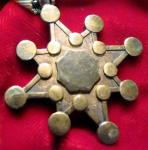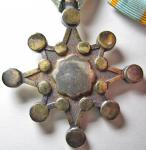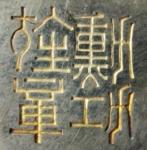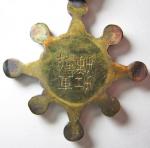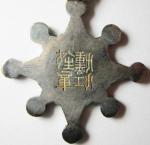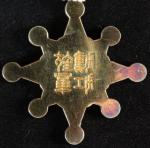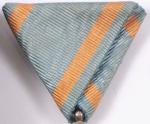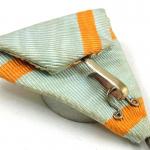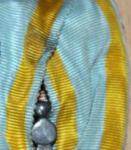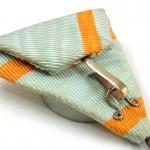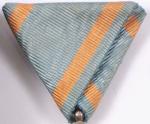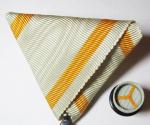-
Posts
22,214 -
Joined
-
Last visited
-
Days Won
68
Content Type
Profiles
Forums
Blogs
Gallery
Events
Store
Everything posted by JapanX
-
Now about form of central mirror. General rule will be "the bigger and less figured central mirror, the older the piece and vice versa" Meiji / Meiji-Taisho / Showa
-
-
Now about the most tricky question - dating of sacred treasures in two lower classes. Collector could use two more or less stable features Form of kanji on reverse Form of central mirror on obverse Let`s start with the reverse Meiji / Meiji-Taisho / Showa
-
Interesting, that usually ribbons for sacred treasure that was made in Germany have more close coloring to the original. Like this ribbon (from 4th class sacred treasure that was issued in 1899 to German officer)
-
But I think it`s obvious that ribbon of our piece has nothing to do with these examples ' alt='' class='ipsImage' > ' alt='' class='ipsImage' > I checked all my ribbons and all ribbons in my scanatheca (a few thousands pieces) - this ribbon has unique, atypical coloring and moire pattern. That`s why I think that this could be not "an early" ribbon, but simply ribbon that was "made outside Japan".
-
As we know earlier ribbons (Meiji/early Taisho) for sacred treasure order have more rich colors. Like this one Or this one
-
-
Let`s start with the ribbon. Colors of the ribbon of Showa piece (late 20s/30s) shoud look like this
-
Tell you the truth guys, I think time period from which this 7th/8th class treasure came from is the key (or at least one of the keys...) If this piece came from Meiji/Taisho epoch, then this medal bar undoubtedly was doctored. If this piece belongs to Showa epoch, then there is still hope (although pretty delusive one) that this bar is original. All we have is ribbon with very unusual coloring + photo of obverse. Unfortunately a) it's hard to date two lower classes of treasures only by obverse b) I don't think that this ribbon was manufactured in Japan I'll try to illustrate my points a) and b) tomorrow.
-
Sold for €150 ... I'd say "fair price"
-
If I remember correctly III Reich longevity awards were introduced only on March 16, 1936. P.S. Indeed the auction is still on! Sorry for that! And the price is already €100 ;)
-
Interesting question especially in light of "Let's say" Why wouldn't he? Certainly no less realistic scenario than "embassy cook, driver or watchmen". But let's say he was an embassy driver. Or cook. Or watchman. How long it would take for embassy driver to get 7th/8th grade of sacred treasure (since it is indeed could be a longevity award) I'd say 20+ years (that is if we apply japanese criterion for awarding japanese citizens with this order) But what about his cross Treue Dienst? He spent all these years in service before 1918? P.S. Personally I saw lower class of sacred treasure awarded to foreigner only once. It was group of awards of Private G.C. Hogbin, 1st batallion, Scots Guards. He was presented with 7th class in 1918 while serving as servant to Lieutenant General Pultney (organizer of 1918 "mission to Japan"). His group of 7 was sold for 1600 GBP. If anybody interested I'll post photo of his group in a couple of days.
-
Hmmm No opinions from "other people" ... Well, let's once again consider all possible scenarios. I think we can safely dismiss Boxer Rebellion. Same goes for WWI since Germany and Japan were in a state of war. This left us with only one possibility for this 8th (7th?) class sacred treasure - late20s/30s. So let's say he was a private/NCO during WWI. Then he was "reactivated" in 30s. All of the sudden - сabbom - he is getting encouragement from his japanese comrades in the form of 8th/7th class of sacred treasure! But for what?! For "strengthening the friendship" between Reich and Empire of Japan as NCO? But with such rank it's hard to "strength" anything (to say nothing about being noticed by Empire of Japan) If he was an officer by this time, then I think he should get higher class of sacred treasure.. Now about this treasure. As I said earlier this order looks like Showa piece to me (although without reverse it's hard to be sure) But ribbon doesn't belong to Showa. It looks like it came from earlier time period (Meiji/early Taisho) Another strange inconsistency... P.S. Btw, it was sold today for €88...
-
Yep
-
Btw, I wonder how seller can be sure that this treasure is 7th class treasure "Orden des Geheiligten Schatzes und des heiligen Spiegels, 7.Klasse" By golden patina around central mirror? But we know that such patina can easily be found on 8th classes ...
-
EK 2 1914 + KVK2 with date 1939 on reverse More correctly will be "according to the seller description of the bar" http://www.ebay.de/itm/Ordensspange-Preusen-Japan-/141120390254?pt=Militaria&hash=item20db6e446e Happy bidding Vladimir!
-

Uncategorised Miniatures of Order of the Lion and the Sun
JapanX replied to JapanX's topic in Middle East & Arab States
Forbavsende! -
Really appreciate it!
-
Definitely! ;)
-
It looks to me that we are talking about dude who spent at least 25 years (according to his bar) in service. On the other hand we have 8th class sacred treasure that looks like Showa piece (!!!) When he got this 8th class? During WWI? Impossible! Later?! But what rank he could held "later"? For 8th class he should be private, schoolteacher, patrol policeman or your postmen. If we are talking about super looser, then next question will be (of course rhetorical one): why Empire of Japan decided to award 8th class sacred treasure to your usual german schoolteacher/private/policeman/etc... ?! P.S. I guess no provenance for this bar either?
-
Cool!
-

Soviet Early Soviet Orders and their Cavaliers
JapanX replied to JapanX's topic in Russia: Soviet Orders, Medals & Decorations
They are See post #14 Same old - construction of new types of airplanes. -
Hi Vladimir, the probability is close to zero Cheers, Nick
-
Rare? Not really, since according to statute this medal was also issued to "...admirals, generals, officers, warrant officers (ensigns), sailors and petty officers who are in reserve (retired) or that were discharged from the Armed Forces of the Russian Federation, the Armed Forces of the USSR, the Federal Border Service of the Russian Federation or Naval Border Troops of the KGB, if they were previously awarded state awards of the Russian Federation, RSFSR or USSR and impeccably served in the Navy, Marines or Naval Forces of the Federal Border Service of the Russian Federation or Naval Border Troops of the KGB on ships or in naval aviation for 10 years or more or in other parts of the navy for 20 years or more; to civilian personnel on support ships of the Navy, seafarers and marine scientists, of river, fishing, research, or expeditionary fleets, if they previously received state awards of the Russian Federation, RSFSR or USSR and worked flawlessly on vessels for 15 years or more, to designers, developers, managers of design bureaus, research institutions and organizations, educational institutions, heads of central government shipbuilding industry, the workers of basic professions directly involved in the construction and repair of ships and vessels, if they previously received state awards of the Russian Federation, RSFSR or the USSR and worked flawlessly in their area of specialty or profession for 20 years or more, to heads of the central basin management bodies, heads of research institutions, educational institutions, sea, river, fishing, research, and expeditionary fleets, if they previously received state awards of the Russian Federation, RSFSR or USSR and worked flawlessly in these areas for more than 20 years"



